Intel NUC5i5RYK Review: A Broadwell-U UCFF PC for Enthusiasts
by Ganesh T S on February 20, 2015 8:00 AM ESTPerformance Metrics - II
In this section, we mainly look at benchmark modes in programs used on a day-to-day basis, i.e, application performance and not synthetic workloads.
x264 Benchmark
First off, we have some video encoding benchmarks courtesy of x264 HD Benchmark v5.0. This is simply a test of CPU performance. As expected, the configurations based on the Core i5-5250U are not as powerful as the Core i7-based ones. The effect of faster memory is almost non-existent. The slightly higher burst frequency of the Core i5-5250U (2.7 GHz) compared to the Core i5-4250U (2.6 GHz) help the NUC5i5RYK take a slight lead over the corresponding Haswell NUC.
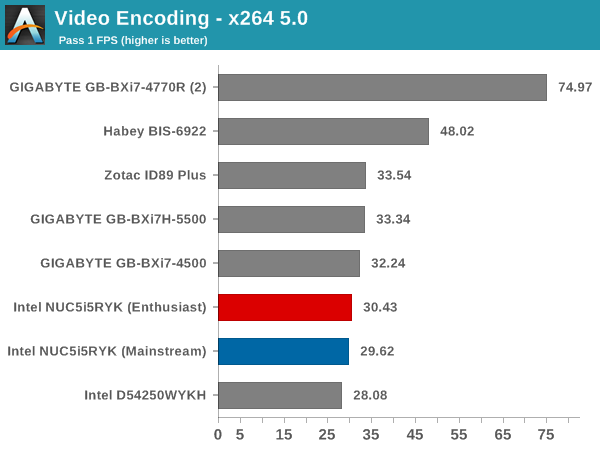
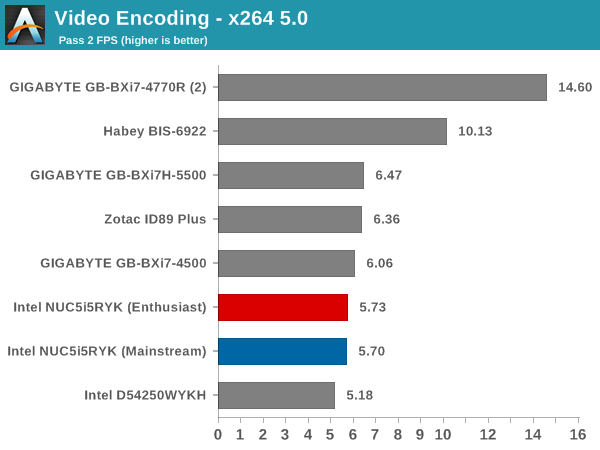
7-Zip
7-Zip is a very effective and efficient compression program, often beating out OpenCL accelerated commercial programs in benchmarks even while using just the CPU power. 7-Zip has a benchmarking program that provides tons of details regarding the underlying CPU's efficiency. In this subsection, we are interested in the compression and decompression MIPS ratings when utilizing all the available threads.
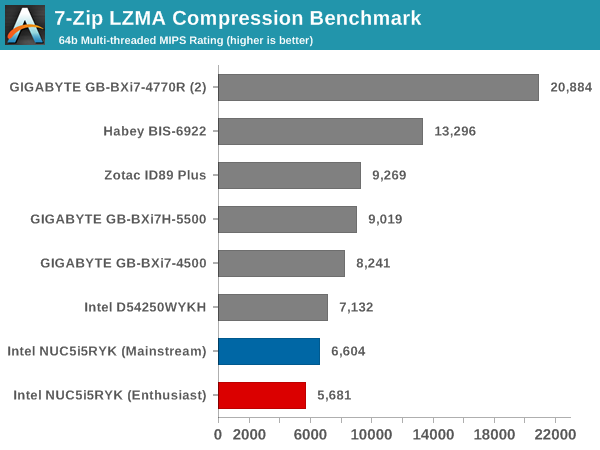
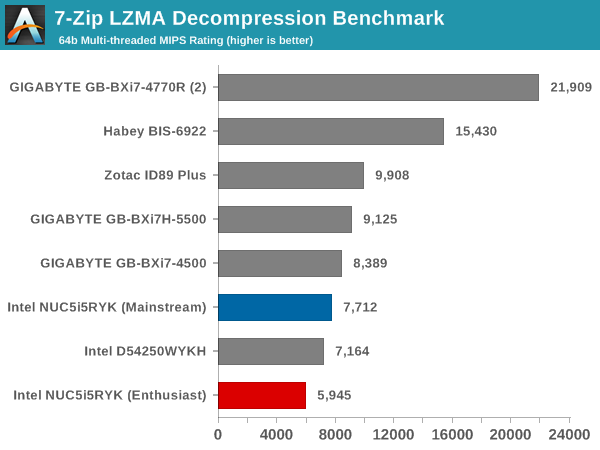
Results in the compression benchmark are similar to what we observed for 3D rendering - Broadwell-U doesn't provide too much benefit over Haswell-U except when burst frequencies play a major role. This is understandable - 14nm helps sustain higher clock rates for the same power consumption.
TrueCrypt
As businesses (and even home consumers) become more security conscious, the importance of encryption can't be overstated. CPUs supporting the AES-NI instruction for accelerating the encryption and decryption processes have, till now, been the higher end SKUs. However, with Bay Trail, even the lowly Atom series has gained support for AES-NI. The Core i5-4200H in the BXi5G-760 does have AES-NI support. TrueCrypt, a popular open-source disk encryption program can take advantage of the AES-NI capabilities. The TrueCrypt internal benchmark provides some interesting cryptography-related numbers to ponder. In the graph below, we can get an idea of how fast a TrueCrypt volume would behave in the Intel NUC5i5RYK and how it would compare with other select PCs. This is a purely CPU feature / clock speed based test.
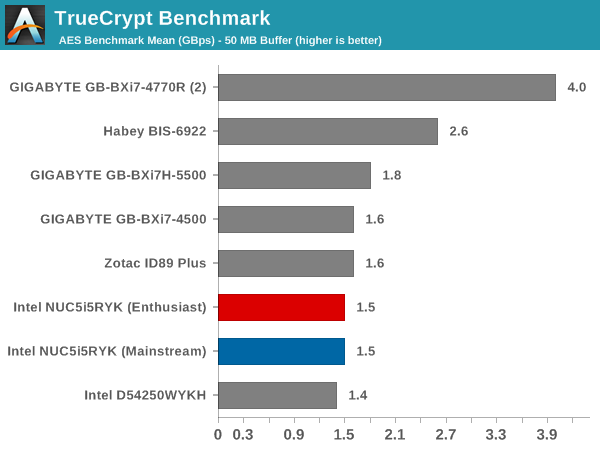
Agisoft Photoscan
Agisoft PhotoScan is a commercial program that converts 2D images into 3D point maps, meshes and textures. The program designers sent us a command line version in order to evaluate the efficiency of various systems that go under our review scanner. The command line version has two benchmark modes, one using the CPU and the other using both the CPU and GPU (via OpenCL). The benchmark takes around 50 photographs and does four stages of computation:
- Stage 1: Align Photographs
- Stage 2: Build Point Cloud (capable of OpenCL acceleration)
- Stage 3: Build Mesh
- Stage 4: Build Textures
We record the time taken for each stage. Since various elements of the software are single threaded, others multithreaded, and some use GPUs, it is interesting to record the effects of CPU generations, speeds, number of cores, DRAM parameters and the GPU using this software.
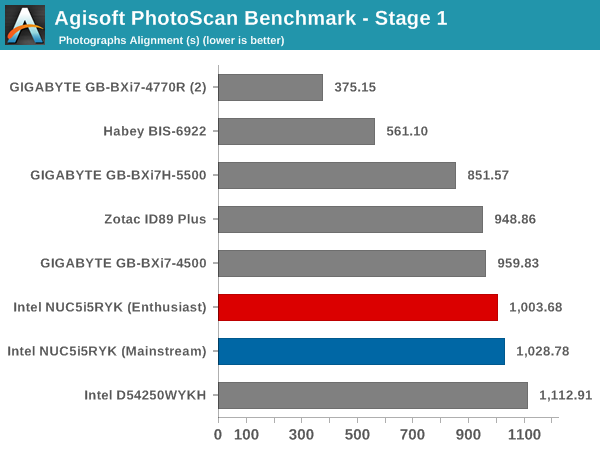
The results show that the faster DRAM helps despite increased latency. GPU acceleration proves beneficial in cutting down the time taken for the second stage considerably.
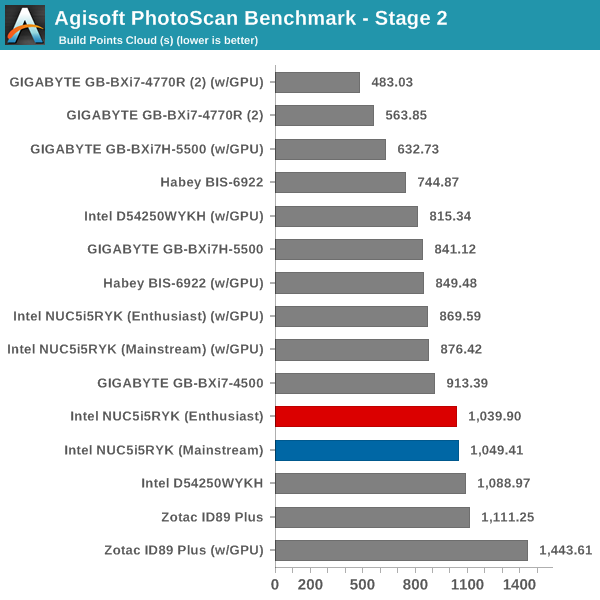

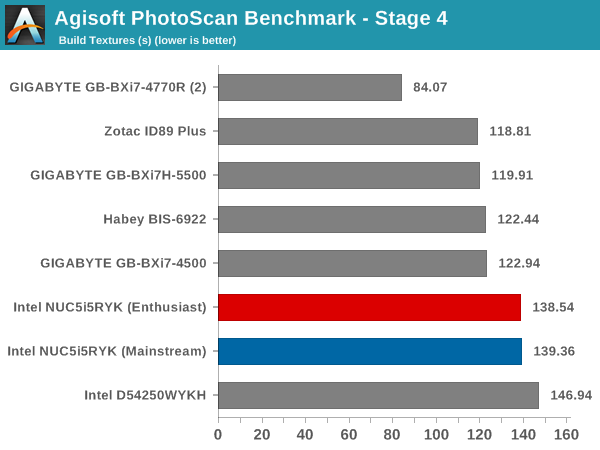
Dolphin Emulator
Wrapping up our application benchmark numbers is the Dolphin Emulator benchmark mode results. This is again a test of the CPU capabilities, and the Core i7-based models obviously trump the Core i5-based ones.











83 Comments
View All Comments
cjs150 - Friday, February 20, 2015 - link
I am a confirmed HTPC user, I have 2 in the house. One, more powerful, is used to rip Blu rays down to NAS, (plus play, Netflix/Amazon Prime, Web browsing) the other is used simply to play movies, browising, word processing and "Old" gaming - I am a big fan of Total War, old versions.Total silent operation is a must. I do not care how quiet the fan is, in soft parts of movie playback I can hear it.
The old i3 NUC, in a fanless case, makes for an excellent low power HPTC. A Broadwell U will be as good.
My problem is then I am not sure even that power is necessary for most HTPC use where simply streaming from NAS or similar external disk. For the next HTPC I am looking forward to reviews of Intels Bay Tree on a stick, so small it could be stuck behind my AV receiver
edzieba - Friday, February 20, 2015 - link
Having 'too much' power for an HTPC has two main advantages:1) Interface speed. This is both for actual rendering of the interface bells & whistles, and for populating large directories when browsing.
2) CODEC futureproofing. H.265 is on the horizon, and Hi10p H.264 has some very nice benefits in bitrate reduction (or better perceptual quality at the same bitrate), but low power hardware that relies on fixed-function decoder blocks will be left high and dry. Even if they DO have a FFB for a desired CODEC, it may not be sufficient to playback all files (e.g. the number of Level 4.0 h.264 decoders that can't handle full-bitrate Blu Ray streams).
Kutark - Tuesday, February 24, 2015 - link
I'm not sure you realize how little processing power is actually used for rendering. Even now on an old dual core pentium my htpc barely hits 10% utilization on one core while watching h.264 stuff at 1080p. My second htpc which has a ~$55 amd 5xxx series card does most of it via the video card, which also is nowhere even close to being taxed.This setup is WWWAAAYYYY past the needs of any kind of streaming/media/htpc. At these price ranges you can actually build a pretty decent desktop with a dedicated graphics card. Yes, it won't be this small, but you will actually have real graphics performance (i.e. a gtx 960 or r9 280, etc).
yankeeDDL - Friday, February 20, 2015 - link
Wouldn't you consider an AMD-based system a better option for an HTPC? Asking as I am considering one.I recently bought an AMD-based laptop and I am extremely pleased with it as I find it much more effective for casual gaming and, frankly, the CPU performance gap with Intel is "irrelevant" for HTPC use (at least the one I have in mind).
cjs150 - Friday, February 20, 2015 - link
YankeeDDL: Short answer is yes, AMD laptop in many cases is a much better HTPC (unless it has a fan!)But will it look good with the rest of your AV kit? My main HTPC is in a HDPLEX 3 case, which looks great (but pricey), my second HTPC is an i3 NUC in a Tranquil fanless case - again fits right into the AV style.
I guess it depends on what you want. Edzieba is clearly much more of a power user of an HTPC than I am. That does make him right and me wrong (or vice versa), just different. But I have yet to find any user of an HTPC who, with all else being equal, would want to have fans in the HTPC if it could run fanless
Flunk - Friday, February 20, 2015 - link
So you're saying an AMD laptop isn't a better HTPC then? Qualifying it with "unless it has a fan" kinda negates the possibility entirely.
BlueBlazer - Saturday, February 21, 2015 - link
Fans have one big problem, dust accumulation and can lead to clogging (in the cooling vents) which can cause overheating.owan - Friday, February 20, 2015 - link
Its not about being a power user... he's talking about why more cpu punch can be a good thing. If you don't have a fixed function decode block for a new codec and your CPU is too crappy to do it in software, then you need to buy a new CPU and mobo. If bay trail on a stick can't do h.265 you're screwed if you try to play h.265 content, but a broadwell NUC might be able to do it in software (assuming it can't decode in hardware... which it may)BlueBlazer - Saturday, February 21, 2015 - link
Agree, I ran into that problem years ago especially with Hi10p (10-bit H.264) which requires software decoding. Those low power slow CPUs (like AMD E-350 and Atom 330) just would not be able to decode it smoothly. Broadwell already has H.265 as well as 10-bit H.265 and VP9 support in its latest drivers: http://techreport.com/news/27677/new-intel-igp-dri...rmullns08 - Friday, February 20, 2015 - link
cjs150: Interesting that you bring up the HDPLEX 3 case. I currently use a D54250WYKH, but have one major complaint with it being the power supply. I don't use mine as much for HTPC, but do use it for an audio setup (Schiit Modi2 Uber/Magni2 Uber and JBL LRS305), and the power supply is so noisy. I've found that the PSU leaks noise on the negative side, into the chassis which is not properly isolated or grounded. Connecting the DAC results in noise shooting through the system even before the USB cable makes actual contact with the NUC. I've tried different surge protectors, relocating devices onto different outlets to no avail. The other day I actually ordered the HDPLEX linear power supply to hopefully resolve the issue once and for all.